Freda Lightfoot's Blog, page 18
September 19, 2011
Latest News
I can't believe that summer is almost over. We set up our new little holiday home here in Southport back in May with lots of summer trips planned. Now it is almost time to head south and return home for the winter like migrating birds. We enjoyed some weeks in the early summer back home by our pool, but I'll admit to relief at being away from the worst of the Spanish heat in late July and August. Instead we've been getting out and about and exploring our beloved home county of Lancashire.
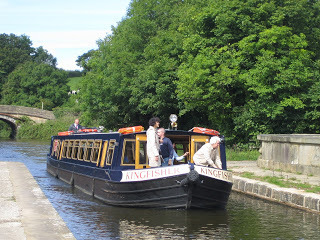
We've cruised on the Leeds-Liverpool canal along the aqueduct over the River Lune, seen the weird statues by Anthony Gormley at Formby that look like real people staring out the sea.
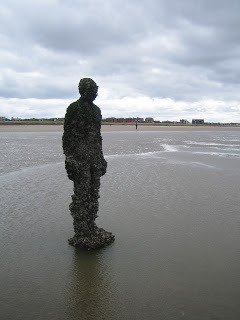
We've enjoyed several trips to the theatre including a marvellous
production of As You Like at the Royal Exchange Theatre, Manchester.
Not to mention various visits to the Lakes, Yorkshire, Wales and Cornwall. I could really get to quite enjoy this life style.

And even been to the races at Haydock Park, although sadly we didn't have a big win.
I've attended the RNA conference, the Writers' Holiday at Caerleon where
I led a course in the historical novel, enjoyed several writerly
lunches, and caught up with writer friends old and new.
I've done talks at Blackpool library and one for Beck Seniors in Kendal. I also spent a most enjoyable morning at Tarleton Library chatting with the writers' group which meets there every Thursday morning. What a great bunch they are.
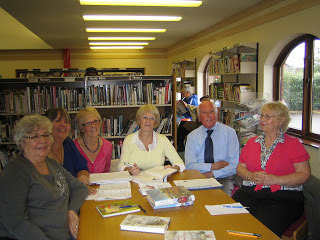
Then there are the National Trust properties we've visited: Rufford Old Hall, Speke Hall, Sizergh, Tatton Park, Dunham Massey, Lyme Park, used as the setting for the famous adaption of Pride and Prejudice where Mr Darcy rose from the lake. Sadly, no Adonis rising from the lake on the day we visited.
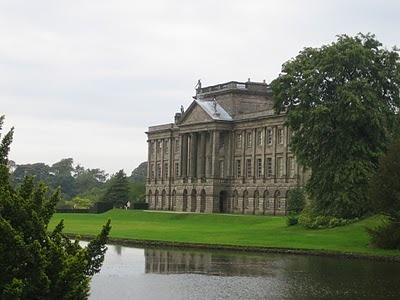
And if you think I've been slacking on the writing front, well maybe, just a bit. But I felt I needed some time off after fifteen long years of labour. However, I have not been entirely idle. I've put up a few more of my back list as ebooks, which are selling steadily.
Available on Apple, Sony, etc. or you can download them from Amazon:
For All Our Tomorrows and Whispering Shadows are on special offer for the month of September.
I've also built a new website, which was another challenge. You can check it out for yourself here and give me your opinion.http://www.fredalightfoot.co.uk
Last but by no means, I have a new saga out:
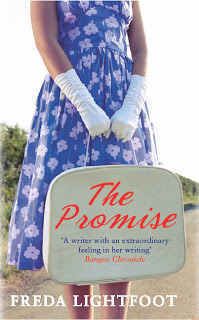
SAN FRANCISCO 1904
Georgia Briscoe, in love with British sailor Ellis Cowper, is unwillingly betrothed to Drew Kemp. Her husband is mired in the San Francisco underworld, with a penchant for gambling and other women. Georgia plans to escape to be with the man she loves but Drew has other ideas. And then comes the earthquake…
LONDON and THE LAKES, 1948
Chrissie Kemp travels to the Lake District to meet her grandmother for the first time, only to discover a shocking family secret. As the truth unfurls, the passion, emotion and astounding love that blossomed in San Francisco is revealed forty years earlier, and three generations of one family are tested to their limits.
ISBN 9780749008291
Allison & Busby
26 September
Hardback 19.99
Giveaway
I am giving away two signed hardback copies of The Promise.
To enter just go to the Goodies page of my website, or click here to visit Goodreads:
Watch out for a giveaway of my latest historical: The Queen and the Courtesan next month.



We've cruised on the Leeds-Liverpool canal along the aqueduct over the River Lune, seen the weird statues by Anthony Gormley at Formby that look like real people staring out the sea.

We've enjoyed several trips to the theatre including a marvellous
production of As You Like at the Royal Exchange Theatre, Manchester.
Not to mention various visits to the Lakes, Yorkshire, Wales and Cornwall. I could really get to quite enjoy this life style.

And even been to the races at Haydock Park, although sadly we didn't have a big win.
I've attended the RNA conference, the Writers' Holiday at Caerleon where
I led a course in the historical novel, enjoyed several writerly
lunches, and caught up with writer friends old and new.
I've done talks at Blackpool library and one for Beck Seniors in Kendal. I also spent a most enjoyable morning at Tarleton Library chatting with the writers' group which meets there every Thursday morning. What a great bunch they are.

Then there are the National Trust properties we've visited: Rufford Old Hall, Speke Hall, Sizergh, Tatton Park, Dunham Massey, Lyme Park, used as the setting for the famous adaption of Pride and Prejudice where Mr Darcy rose from the lake. Sadly, no Adonis rising from the lake on the day we visited.

And if you think I've been slacking on the writing front, well maybe, just a bit. But I felt I needed some time off after fifteen long years of labour. However, I have not been entirely idle. I've put up a few more of my back list as ebooks, which are selling steadily.
Available on Apple, Sony, etc. or you can download them from Amazon:
For All Our Tomorrows and Whispering Shadows are on special offer for the month of September.
I've also built a new website, which was another challenge. You can check it out for yourself here and give me your opinion.http://www.fredalightfoot.co.uk
Last but by no means, I have a new saga out:

SAN FRANCISCO 1904
Georgia Briscoe, in love with British sailor Ellis Cowper, is unwillingly betrothed to Drew Kemp. Her husband is mired in the San Francisco underworld, with a penchant for gambling and other women. Georgia plans to escape to be with the man she loves but Drew has other ideas. And then comes the earthquake…
LONDON and THE LAKES, 1948
Chrissie Kemp travels to the Lake District to meet her grandmother for the first time, only to discover a shocking family secret. As the truth unfurls, the passion, emotion and astounding love that blossomed in San Francisco is revealed forty years earlier, and three generations of one family are tested to their limits.
ISBN 9780749008291
Allison & Busby
26 September
Hardback 19.99
Giveaway
I am giving away two signed hardback copies of The Promise.
To enter just go to the Goodies page of my website, or click here to visit Goodreads:
Watch out for a giveaway of my latest historical: The Queen and the Courtesan next month.

Published on September 19, 2011 08:37
August 27, 2011
Is accuracy important in historical fiction?
Sebastian Faulks when interviewed on radio 4 described himself as a novelist whose books happen to be set in the past. 'For me,' he said, 'the use of historical settings is to cast the present in a more interesting and broader light.'
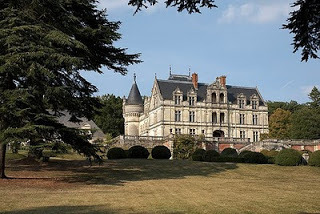
People are clearly more important to him than circumstantial detail. Some novels are so deeply researched they seem like non-fiction in disguise. In a romance they can kill the story dead by boring the reader. Even so, we must do our research and set the scene as accurately as we can. We can take some liberties, for the sake of the story, but if we veer too far from the facts as we know them, the reader may feel cheated and lose faith in the work. If a mistake crops up, an anachronism, this will jar the reader, and jerk them out of the story back to the present.
It's also best also to avoid controversy or anything doubtful which has a hint of being anachronistic. It hasn't so much to be correct as to feel correct. E.g: Soldiers did play baseball in the American Civil War. I believe they also played in a Jane Austen novel too, but the reader may find that hard to accept.
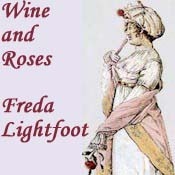
Societies traditions, moral mores and customs help to build the picture, but this is where even the most fanatical historian can come unstuck. Many time periods, such as the Regency, have become so stylised that you may actually be considered to have written a historically inaccurate book if you do not follow the "popular perceptions" of the period. Presenting a realistic, complex view of Society during a specific era can be the thing that makes the difference between a passable yarn and a gripping story.
Wine and Roses available from Regency Reads
It's surely about striking the right balance. The story is the most important thing, but it must be firmly rooted in its world. It must not simply be a costume drama. The past must be made as relevant as the present. The problems are the same, human emotion, conflict and behaviour. Falling in love and losing that love are just as painful.
Bernard Cornwell said: 'Essentially the background has to be right because it's the detail of the background that pins down the fiction in the foreground.'
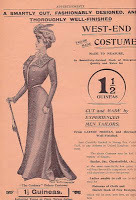
It's a combination of accuracy and imagination to give credibility, create atmosphere, and make the story plausable. The writer needs to incorporate the odd, quirky detail. Perhaps the price of cheese, a housemaid's monthly wage, a description of underwear, length of time for a journey, breed of horse, how someone would get their boots mended, what book or newspaper they might read. How would they conduct a funeral, spin wool, pluck a hen, fire a rifle, fight a duel or take part in a bare knuckle fight. Whatever is needed for your story.
When I can't draw on personal experience or memories I use interviews, explore diaries, memoirs, biographies, newspapers, etc. I select with care and don't put material in just to show off how much I've learnt. It is the attention to small detail which builds the atmosphere, and a strong sense of time and place which creates that feeling of reality and verisimilitude which is vital for the reader to sit back and enjoy the ride.



People are clearly more important to him than circumstantial detail. Some novels are so deeply researched they seem like non-fiction in disguise. In a romance they can kill the story dead by boring the reader. Even so, we must do our research and set the scene as accurately as we can. We can take some liberties, for the sake of the story, but if we veer too far from the facts as we know them, the reader may feel cheated and lose faith in the work. If a mistake crops up, an anachronism, this will jar the reader, and jerk them out of the story back to the present.
It's also best also to avoid controversy or anything doubtful which has a hint of being anachronistic. It hasn't so much to be correct as to feel correct. E.g: Soldiers did play baseball in the American Civil War. I believe they also played in a Jane Austen novel too, but the reader may find that hard to accept.

Societies traditions, moral mores and customs help to build the picture, but this is where even the most fanatical historian can come unstuck. Many time periods, such as the Regency, have become so stylised that you may actually be considered to have written a historically inaccurate book if you do not follow the "popular perceptions" of the period. Presenting a realistic, complex view of Society during a specific era can be the thing that makes the difference between a passable yarn and a gripping story.
Wine and Roses available from Regency Reads
It's surely about striking the right balance. The story is the most important thing, but it must be firmly rooted in its world. It must not simply be a costume drama. The past must be made as relevant as the present. The problems are the same, human emotion, conflict and behaviour. Falling in love and losing that love are just as painful.
Bernard Cornwell said: 'Essentially the background has to be right because it's the detail of the background that pins down the fiction in the foreground.'

It's a combination of accuracy and imagination to give credibility, create atmosphere, and make the story plausable. The writer needs to incorporate the odd, quirky detail. Perhaps the price of cheese, a housemaid's monthly wage, a description of underwear, length of time for a journey, breed of horse, how someone would get their boots mended, what book or newspaper they might read. How would they conduct a funeral, spin wool, pluck a hen, fire a rifle, fight a duel or take part in a bare knuckle fight. Whatever is needed for your story.
When I can't draw on personal experience or memories I use interviews, explore diaries, memoirs, biographies, newspapers, etc. I select with care and don't put material in just to show off how much I've learnt. It is the attention to small detail which builds the atmosphere, and a strong sense of time and place which creates that feeling of reality and verisimilitude which is vital for the reader to sit back and enjoy the ride.

Published on August 27, 2011 05:06
August 19, 2011
Southport Flower Show
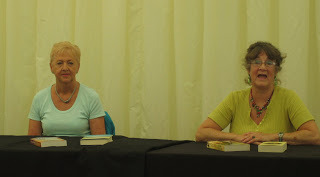
Had a lovely day out yesterday at Southport Flower Show. Listened to June Francis and Lyn Andrews giving a talk, organised by Pritchards Books. Erica James will be there on Saturday, if there are any of her fans out there.
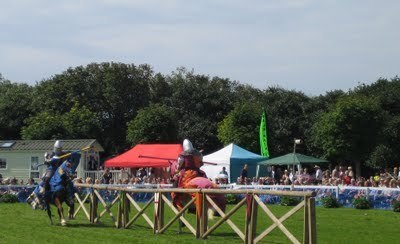
After that we watched some medieval knights jousting, a dog display team, some birds of prey which were absolutely beautiful, and lastly a most entertaining and skilful performance by two collies rounding up ducks. Great fun.


There were also some wonderful show gardens, flower displays, huge vegetables (do they really taste good?) Here are some gold medal winners.



And where's Dame Edna Everage when you need her?

The show runs till Sunday21st August. I for one will be sure to visit next year too.

Published on August 19, 2011 05:19
August 9, 2011
Montgomery Castle
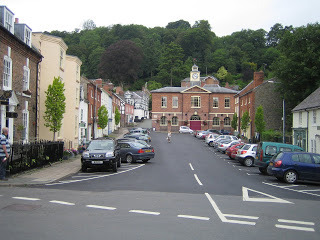
If you're looking for a lovely place for a day out in Wales, try Montgomery. This delightful little town still has the kind of small shops you thought had quite disappeared in this age of supermarkets and big chains. But here they seem to flourish in all their individuality, selling cookery books, crafts, pictures, clothes, and delicious delicacies to tempt the taste buds.
We spent a happy hour exploring the town's museum, which was rather like the tardis, small and insignificant on the outside but large and fascinating within. Here we could examine tools used by local craftsmen, the bread oven and brewing vat from when the building was once an inn, and upstairs we learned about the local workhouse, the civil war, and other important dates in the history of the town.

High above the town stands Montgomery Castle. The original motte and bailey, known as Hen Domen, was built at the order of Roger de Montgomery, earl of Shrewsbury circa 1071.
Robert of Belleme, son of Roger, took part in a revolt in 1077 against William the Conqueror. This rebellion was quickly put down and the participants generously pardoned. As a consequence, William decreed that garrisons be placed in all baronial castles of importance, in order to make future rebellion more difficult.
Robert inherited his mother Mabel's property when she was killed in 1082, an area which comprised part of the region between Normandy and Maine. It is due to this inheritance that Robert has come be known as of Bellême rather than of Montgomery. William the Conqueror died in 1087 and Robert's first act on hearing the news was to expel the ducal garrisons from his own castles.
By 1102 the castle was in the hands of Baldwin de Boulers, and it is from Baldwin that Montgomery gets its Welsh name, Trefaldwyn (Baldwins town). The de Boulers held the castle until 1215 when the fortress was destroyed by Prince Llywelyn ab Iorwerth.

The rebuilding of Montgomery Castle in stone was commenced circa 1223 slightly to the south-east of the original wooden version. The architect of the new castle was Hubert de Burgh who also rebuilt Skenfrith, Grosmont, and White Castle in the Welsh Marches. From 1223 until 1228 masons built the inner ward, or donjon, on a huge rock overlooking the town of Montgomery. A gatehouse was also built, two towers and a curtain wall, a necessary defence as the castle was subjected to many attacks over the years, battered by various Welsh wars, and in the English civil war in 1643 when Edward Herbert, 1st Baron Herbert of Chirbury, was forced to surrender the castle to Parliamentary troops by order of Parliament.

It is now little more than a ruin, if a stark, atmospheric one, and still worth a visit. You walk across a modern wooden bridge into the inner ward from where you have the most marvellous views of the town and the surrounding countryside. It's worth the walk for that alone.

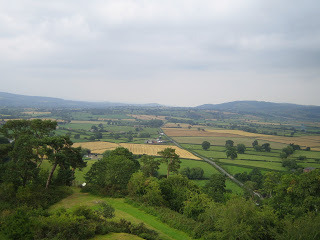

I'd be interested to learn if anyone knows why this particular circle of stones is built the way it is. Could it be part of a threshing circle? Or something to do with a former chapel? The pattern does not seem to be accidental. A mystery we may never solve.

Published on August 09, 2011 09:11
August 1, 2011
Writers´ Holiday
For anyone feeling a little jaded with their writing and in need of a break, then I can't recommend Writers' Holiday highly enough. It takes place at the end of July each year at the Caerleon Campus, University of Wales College, Caerleon, Newport, South Wales.
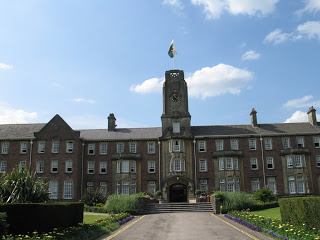
Personally planned and supervised by Gerry and Anne Hobbs, nothing is too much trouble for them. It runs from Sunday afternoon through to Friday morning, with no less than fourteen courses to choose from. I was leading one on the historical novel in the second half of the week, so in the first part I chose the painting course. I doubt I'll be putting my picture on my wall but it was great fun to do, and my first effort with acrylics.
The course got off to a lively start with a most entertaining talk by Ray Allen. I've heard him before but he never disappoints. On Monday afternoon Julie Cohen told us about her struggles to get published, her writing life, as well as letting us in on many of her writing secrets. She was a generous and lively speaker and I should think everyone would rush out to buy her wonderful books as a result. On Tuesday we listened to Leila and Ali Dewji tell us about their new publishing venture: Acorn Press. For anyone interested in going down the self-publishing route and needs support, they certainly seemed to have the necessary expertise.
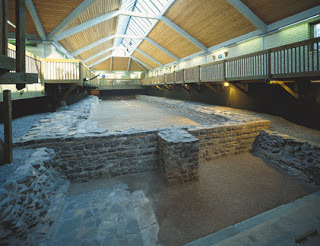
Wednesday was excursion day, but I chose to visit the Roman Museum and baths in Caerleon itself, which were pretty impressive. Far bigger than I´d expected, and with such realistic sound effects I half expected to see a Roman diving in. I did, of course, manage to squeeze in a chocolate muffin and cup of tea somewhere along the way.
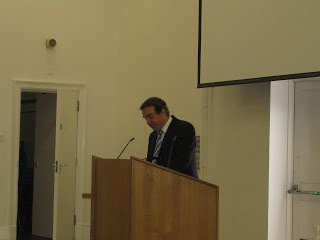
Here is John Townsend, children´s author, reading one of his delightful poems. I can quite see why children love his books so much. John specialises in writing for special needs.
After tea each day there were several interesting talks to choose from on a wide variety of topics, followed by Tai Chi for the enthusiasts among us.But there´s also plenty of time to share writing experiences, pick up tips, or just sit and chat.
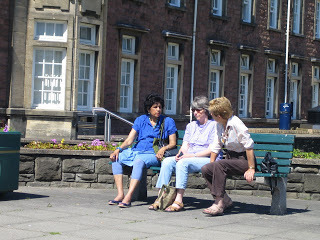
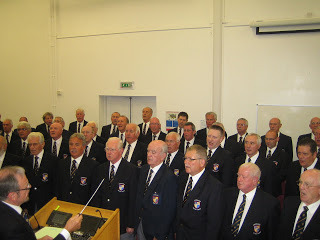
On the last night, Thursday evening, we were royally entertained by the Cwmbach Male Choir, which made my heart soar. What power they possess in those wonderful Welsh voices. Afterwards they repaired to the bar to sing some more. This is only half of them as there were 60 in all.
150 delegates stay in single en-suite accommodation, albeit of the basic student variety, but perfectly adequate, and you can request a ground floor room if you wish. I clattered up an iron staircase to one on the third floor which was fine, next door to the kitchen so I could make myself a cup of tea or coffee whenever I wished. I'd recommend taking your own pillow if you can carry one, as only one was provided. And coat hangers seem rare, but other than that I had no complaints.
I came away stimulated and inspired, having had great fun, a catch-up with old friends and made many new ones as everyone is most welcoming. Oh, and I booked for next year.
For more information take a look here:
http://www.writersholiday.net/caerleon.htm



Personally planned and supervised by Gerry and Anne Hobbs, nothing is too much trouble for them. It runs from Sunday afternoon through to Friday morning, with no less than fourteen courses to choose from. I was leading one on the historical novel in the second half of the week, so in the first part I chose the painting course. I doubt I'll be putting my picture on my wall but it was great fun to do, and my first effort with acrylics.
The course got off to a lively start with a most entertaining talk by Ray Allen. I've heard him before but he never disappoints. On Monday afternoon Julie Cohen told us about her struggles to get published, her writing life, as well as letting us in on many of her writing secrets. She was a generous and lively speaker and I should think everyone would rush out to buy her wonderful books as a result. On Tuesday we listened to Leila and Ali Dewji tell us about their new publishing venture: Acorn Press. For anyone interested in going down the self-publishing route and needs support, they certainly seemed to have the necessary expertise.

Wednesday was excursion day, but I chose to visit the Roman Museum and baths in Caerleon itself, which were pretty impressive. Far bigger than I´d expected, and with such realistic sound effects I half expected to see a Roman diving in. I did, of course, manage to squeeze in a chocolate muffin and cup of tea somewhere along the way.

Here is John Townsend, children´s author, reading one of his delightful poems. I can quite see why children love his books so much. John specialises in writing for special needs.
After tea each day there were several interesting talks to choose from on a wide variety of topics, followed by Tai Chi for the enthusiasts among us.But there´s also plenty of time to share writing experiences, pick up tips, or just sit and chat.


On the last night, Thursday evening, we were royally entertained by the Cwmbach Male Choir, which made my heart soar. What power they possess in those wonderful Welsh voices. Afterwards they repaired to the bar to sing some more. This is only half of them as there were 60 in all.
150 delegates stay in single en-suite accommodation, albeit of the basic student variety, but perfectly adequate, and you can request a ground floor room if you wish. I clattered up an iron staircase to one on the third floor which was fine, next door to the kitchen so I could make myself a cup of tea or coffee whenever I wished. I'd recommend taking your own pillow if you can carry one, as only one was provided. And coat hangers seem rare, but other than that I had no complaints.
I came away stimulated and inspired, having had great fun, a catch-up with old friends and made many new ones as everyone is most welcoming. Oh, and I booked for next year.
For more information take a look here:
http://www.writersholiday.net/caerleon.htm

Published on August 01, 2011 10:24
July 28, 2011
Status of Women in Sixteenth Century France
'Frenchwomen,' said a critic, 'are very devout in seeming, but in point of fact they are very light and very free. Every one of them, even if she be a courtesan, wishes to be treated as an honest woman, and there is no lady of bad fame who has not some objection to make to the morals of her neighbour. Their manners and talk are most agreeable, but one fault they have and that is avarice.'
Nuns, apparently, were worse. But then many were quite secular in their habits, certainly Henry IV of France enjoyed affairs with several, including Marie de Beauvilliers, abbess of Montmartre, and possibly several others. He did like to spread his favours.
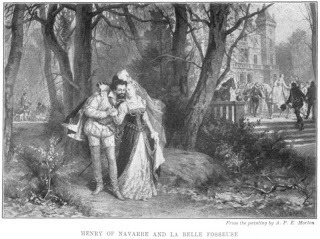
Women often chose to enter a nunnery, considering this a better option than marrying a man they didn't care for. And who could blame them since most marriages, and even being chosen as someone's mistress, was often outside a woman's control.
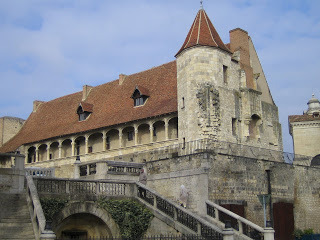 Others were incarcerated in a religious house by a husband with an eye to finding a new wife, a danger which threatens Queen Margot in The Reluctant Queen. This is the sequel to Hostage Queen and continues the story of Marguerite de Valois as she is reunited with her philandering husband in his castle at Nerac. Nothing quite works out as she hoped as there is a rival for Henry's affection in the delectable form of La Belle Corisande. Margot is ultimately forced to run, but can she escape with her life...?
Others were incarcerated in a religious house by a husband with an eye to finding a new wife, a danger which threatens Queen Margot in The Reluctant Queen. This is the sequel to Hostage Queen and continues the story of Marguerite de Valois as she is reunited with her philandering husband in his castle at Nerac. Nothing quite works out as she hoped as there is a rival for Henry's affection in the delectable form of La Belle Corisande. Margot is ultimately forced to run, but can she escape with her life...?
The next love in Henry's life is Gabrielle d'Estrée whose one wish is to marry for love, but her mother sells her as a mistress to three different men before she catches the eye – and the heart – of Henry of Navarre, now King of France. Henry promises to marry her, but Gabrielle's difficulties have only just begun...
Is the love of a king enough to secure Gabrielle both the happiness and respectability she craves and a crown for their son as the next dauphin of France?
What struck me most about Renaissance women when doing my research was how independent and well educated many of them were. Margot was proficient in French, Italian, Latin, Greek, music and mathematics as well as her devotions. But it wasn't only royalty and the aristocracy who believed in education. The bourgeoisie were also great advocates of such refinements. It was considered that an educated woman was better able to maintain her family's health, raise her children well, make her husband content and keep a household in order. The reformation also encouraged education for girls so that they were able to read the scriptures for themselves and be spiritually closer to God.
Daughters were, however, kept very much on a tight rein. They were expected to walk behind their mothers, and were rigorously attended and chaperoned at all times. When travelling they were expected to ride en croupe behind a servant, observing the proprieties by clinging only to the pommel and not by putting their arms about the servant's waist. Clearly that would have been beyond the pale. Nor were young ladies allowed to drink, although their mothers might be allowed to add a splash of Burgundy to give their water a little colour and flavour.
'But their deportment,' said an observer, 'conveyed rather their good taste than their truth.'
So, a passion for women's rights simmered beneath the surface. How wonderful! Men grumbled, of course, at women's independence, just as they do now. Nothing changes! They complained that their wives talked too much, stopping to gossip with passers-by in the street. They objected about their readiness to go alone to church or market, often being out and about for hours at a time, and 'their husbands never daring to ask where they were.'
Marriage was less about love and more about wealth, position and power, which meant, as we romantic novelists know, plenty of opportunity for extra-curricular activity in the way of affaires. Henry IV is reputed to have enjoyed at least 60 mistresses, and sired numerous children with 11 of them, and probably many more we don't even know of. He is said to have provided for them well and been a loving father. Nevertheless, he had great difficulty winning Gabrielle, and was greatly jealous of every man who looked her way. But with such a beauty who can blame him?
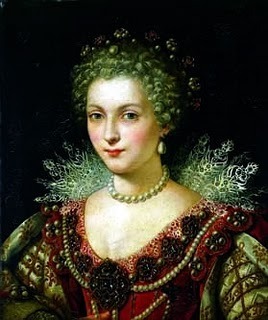
The proprieties and ritual of marriage began with les accords when the happy couple joined hands in the presence of their parents. Next came the fiançailles when the bans were published. The parents, bride and bridegroom would visit the curé together to attend to this important matter. Then came the Epousailles which of course took place in church. The bridegroom was not allowed to enter without giving a considerable sum in alms, and guests were chosen to attend the wedding breakfast with an eye to the money they'd be likely to give. A bowl was handed round at dinner into which donations for a 'nest-egg' for the couple could be dropped.
One amusing rule I found for widows, was that they were obliged to wear a high necked dress, long cloak and a veil, and in Italy the authorities felt obliged to pass a law restricting the style as widows' veils had become 'dangerously attractive.' You can't keep a bad girl down.
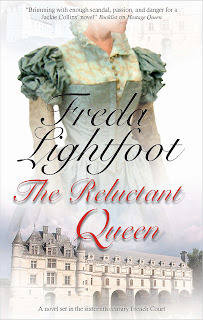
The Reluctant Queen
out in paperback late July/early August
View it here on Amazon.


Nuns, apparently, were worse. But then many were quite secular in their habits, certainly Henry IV of France enjoyed affairs with several, including Marie de Beauvilliers, abbess of Montmartre, and possibly several others. He did like to spread his favours.

Women often chose to enter a nunnery, considering this a better option than marrying a man they didn't care for. And who could blame them since most marriages, and even being chosen as someone's mistress, was often outside a woman's control.
 Others were incarcerated in a religious house by a husband with an eye to finding a new wife, a danger which threatens Queen Margot in The Reluctant Queen. This is the sequel to Hostage Queen and continues the story of Marguerite de Valois as she is reunited with her philandering husband in his castle at Nerac. Nothing quite works out as she hoped as there is a rival for Henry's affection in the delectable form of La Belle Corisande. Margot is ultimately forced to run, but can she escape with her life...?
Others were incarcerated in a religious house by a husband with an eye to finding a new wife, a danger which threatens Queen Margot in The Reluctant Queen. This is the sequel to Hostage Queen and continues the story of Marguerite de Valois as she is reunited with her philandering husband in his castle at Nerac. Nothing quite works out as she hoped as there is a rival for Henry's affection in the delectable form of La Belle Corisande. Margot is ultimately forced to run, but can she escape with her life...?The next love in Henry's life is Gabrielle d'Estrée whose one wish is to marry for love, but her mother sells her as a mistress to three different men before she catches the eye – and the heart – of Henry of Navarre, now King of France. Henry promises to marry her, but Gabrielle's difficulties have only just begun...
Is the love of a king enough to secure Gabrielle both the happiness and respectability she craves and a crown for their son as the next dauphin of France?
What struck me most about Renaissance women when doing my research was how independent and well educated many of them were. Margot was proficient in French, Italian, Latin, Greek, music and mathematics as well as her devotions. But it wasn't only royalty and the aristocracy who believed in education. The bourgeoisie were also great advocates of such refinements. It was considered that an educated woman was better able to maintain her family's health, raise her children well, make her husband content and keep a household in order. The reformation also encouraged education for girls so that they were able to read the scriptures for themselves and be spiritually closer to God.
Daughters were, however, kept very much on a tight rein. They were expected to walk behind their mothers, and were rigorously attended and chaperoned at all times. When travelling they were expected to ride en croupe behind a servant, observing the proprieties by clinging only to the pommel and not by putting their arms about the servant's waist. Clearly that would have been beyond the pale. Nor were young ladies allowed to drink, although their mothers might be allowed to add a splash of Burgundy to give their water a little colour and flavour.
'But their deportment,' said an observer, 'conveyed rather their good taste than their truth.'
So, a passion for women's rights simmered beneath the surface. How wonderful! Men grumbled, of course, at women's independence, just as they do now. Nothing changes! They complained that their wives talked too much, stopping to gossip with passers-by in the street. They objected about their readiness to go alone to church or market, often being out and about for hours at a time, and 'their husbands never daring to ask where they were.'
Marriage was less about love and more about wealth, position and power, which meant, as we romantic novelists know, plenty of opportunity for extra-curricular activity in the way of affaires. Henry IV is reputed to have enjoyed at least 60 mistresses, and sired numerous children with 11 of them, and probably many more we don't even know of. He is said to have provided for them well and been a loving father. Nevertheless, he had great difficulty winning Gabrielle, and was greatly jealous of every man who looked her way. But with such a beauty who can blame him?

The proprieties and ritual of marriage began with les accords when the happy couple joined hands in the presence of their parents. Next came the fiançailles when the bans were published. The parents, bride and bridegroom would visit the curé together to attend to this important matter. Then came the Epousailles which of course took place in church. The bridegroom was not allowed to enter without giving a considerable sum in alms, and guests were chosen to attend the wedding breakfast with an eye to the money they'd be likely to give. A bowl was handed round at dinner into which donations for a 'nest-egg' for the couple could be dropped.
One amusing rule I found for widows, was that they were obliged to wear a high necked dress, long cloak and a veil, and in Italy the authorities felt obliged to pass a law restricting the style as widows' veils had become 'dangerously attractive.' You can't keep a bad girl down.

The Reluctant Queen
out in paperback late July/early August
View it here on Amazon.

Published on July 28, 2011 00:00
July 18, 2011
How to format an ebook for Kindle
The important thing in formatting for ebooks is to keep things as clean and simple as possible.
Basic requirements are:
1. No page numbers.
2. One space only after a full stop.
3. 1.5 spacing between lines.
4. Left align. Do not justify.
5. Times New Roman 12 (Don't use fancy font. Kindle will change it to TNR anyway, so you might as well save it the job of converting.)
6. It is essential not to use the tab key. Instead use the return key, or the slide rule just below the toolbar to 0.5cm. Better still use the Format/Style manager section.
Step 1
Start by clicking on Edit/Select All
You'll find Format/Style somewhere on your toolbar, depending which version of Word you are using. It will list All Styles available. You might not wish to mess with Normal so choose Body Text or something similar. (I use Body Text First Indent). Stick to one only. You can modify it to the requirements listed above by clicking on font, then paragraph, (see below) and finally choose the language. To add an indent click on Special/First Line, and in the By: box put 0.5
Set the before and after spacing to 0 pt.

Click OK and apply. The document should be reformatted. This format should also now be offered on your toolbar.
Step 2
To see what you are doing when formatting click the show/hide feature on your toolbar designated by the mark. (This will show paragraph returns, extra spaces as dots, tabs or any other strange formatting. If it's not in your toolbar, you can usually find it in Tools/Options/View and then under Formatting Marks.) If it shows up any odd little right facing arrows this is evidence that you've used your tab key.
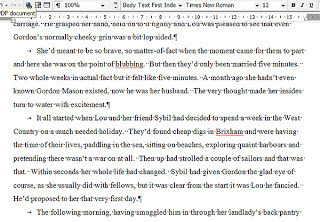
Here's a quick way to delete them:
Click on Edit/Select All
Click Find/Replace/More.
Click Special and select Tab Character from the list.
Leave the Replace box blank
Click - Replace All.
(The screen will tell you how many tabs were deleted.)
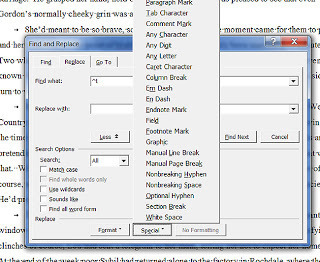
Now use Find and replace to change two spaces to one space after a full stop.
You can also use Find and replace to change straight quotes into curly ones, which Smashwords prefer.
Hyphens which were put in with the ctrl key and found at the end of lines in a print book, can be anywhere on the page of an ebook. They will create a break in the word which irritates the reader. To eliminate them click on Find/More/Special and choose optional hyphen. Leave Replace blank. Click Replace All.
Step 3
As you go through the document you may choose not to indent after a time break, in which case just manually delete the indent.
Alternatively you can select the line - right click/click Paragraph/By… and replace the 0.5 with 0. OK (or Enter)
Check through till you're happy with what you've done.


Basic requirements are:
1. No page numbers.
2. One space only after a full stop.
3. 1.5 spacing between lines.
4. Left align. Do not justify.
5. Times New Roman 12 (Don't use fancy font. Kindle will change it to TNR anyway, so you might as well save it the job of converting.)
6. It is essential not to use the tab key. Instead use the return key, or the slide rule just below the toolbar to 0.5cm. Better still use the Format/Style manager section.
Step 1
Start by clicking on Edit/Select All
You'll find Format/Style somewhere on your toolbar, depending which version of Word you are using. It will list All Styles available. You might not wish to mess with Normal so choose Body Text or something similar. (I use Body Text First Indent). Stick to one only. You can modify it to the requirements listed above by clicking on font, then paragraph, (see below) and finally choose the language. To add an indent click on Special/First Line, and in the By: box put 0.5
Set the before and after spacing to 0 pt.

Click OK and apply. The document should be reformatted. This format should also now be offered on your toolbar.
Step 2
To see what you are doing when formatting click the show/hide feature on your toolbar designated by the mark. (This will show paragraph returns, extra spaces as dots, tabs or any other strange formatting. If it's not in your toolbar, you can usually find it in Tools/Options/View and then under Formatting Marks.) If it shows up any odd little right facing arrows this is evidence that you've used your tab key.

Here's a quick way to delete them:
Click on Edit/Select All
Click Find/Replace/More.
Click Special and select Tab Character from the list.
Leave the Replace box blank
Click - Replace All.
(The screen will tell you how many tabs were deleted.)

Now use Find and replace to change two spaces to one space after a full stop.
You can also use Find and replace to change straight quotes into curly ones, which Smashwords prefer.
Hyphens which were put in with the ctrl key and found at the end of lines in a print book, can be anywhere on the page of an ebook. They will create a break in the word which irritates the reader. To eliminate them click on Find/More/Special and choose optional hyphen. Leave Replace blank. Click Replace All.
Step 3
As you go through the document you may choose not to indent after a time break, in which case just manually delete the indent.
Alternatively you can select the line - right click/click Paragraph/By… and replace the 0.5 with 0. OK (or Enter)
Check through till you're happy with what you've done.

Published on July 18, 2011 02:52
July 13, 2011
A New Direction
I'm a compulsive buyer of books, both new and second hand and one day while browsing along my shelves I spotted one I'd bought years ago in Hay-on-Wye. It was called Queen of Hearts, written back in the 60s by Charlotte Haldane. It proved to be an autobiography of Marguerite de Valois and as I began to read I was immediately intrigued. Margot, as she was familiarly known, was no average woman, rather one born before her time, and I wanted to know more about her. So I began on a journey of twelve months research and discovery which led me to write a stirring tale of her adventures, her intrigues and passions, and the dangers she faced in the sixteenth century French Court.
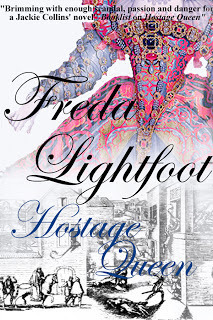 The trilogy begins with Hostage Queen where Margot's mother, who was Catherine de Medici, marries her off to Henry of Navarre, despite Margot being a Catholic and Henry a Huguenot, in order to bring to an end to years of religious wars. Margot wasn't exactly thrilled by the prospect as she was in love with Henri de Guise. But as with all royal princesses, she was expected to bring political benefit through marriage. Within days of their wedding Paris was embroiled in the Massacre of St Bartholomew and the couple are kept virtual prisoners in the Louvre. Navarre was a likeable enough fellow but not the faithful sort. Once Margot realised this, she started a love affair with Guise, a dangerous undertaking, and intrigue and scandal surrounded her at every turn. Margot lived in fear of her life while recklessly flouting convention as far as she dare. Somehow she had to save her husband's life, help him to escape, and then follow him to safety. A task fraught with danger… Buy Hostage Queen on Amazon:
The trilogy begins with Hostage Queen where Margot's mother, who was Catherine de Medici, marries her off to Henry of Navarre, despite Margot being a Catholic and Henry a Huguenot, in order to bring to an end to years of religious wars. Margot wasn't exactly thrilled by the prospect as she was in love with Henri de Guise. But as with all royal princesses, she was expected to bring political benefit through marriage. Within days of their wedding Paris was embroiled in the Massacre of St Bartholomew and the couple are kept virtual prisoners in the Louvre. Navarre was a likeable enough fellow but not the faithful sort. Once Margot realised this, she started a love affair with Guise, a dangerous undertaking, and intrigue and scandal surrounded her at every turn. Margot lived in fear of her life while recklessly flouting convention as far as she dare. Somehow she had to save her husband's life, help him to escape, and then follow him to safety. A task fraught with danger… Buy Hostage Queen on Amazon:
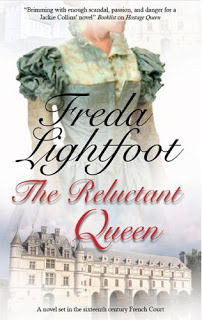
The second book, Reluctant Queen, continues the story of Henry IV and Margot, of what happened when she was reunited with her husband in Nerac, and with her relationship with Guise. It then moves on to Henry's mistress, Gabrielle d'Estrées. History tells us that when Gabrielle was sixteen years old she was so lovely that her mother sold her as a mistress to Henri III. A most unnatural mother if ever there was one. Gabrielle, however, got the worst of the deal as she was passed on from lover to lover, including the Cardinal de Guise, who she was with for more than a year until May 1588 when he left for Paris to support his nephew, the Duke de Guise, in what became known as the Day of the Barricades. And then she caught the eye of the new King Henry IV. Margot absolutely refuses to divorce him in order to allow him to marry his whore, but there are more ways than one of getting rid of a troublesome wife…
Out in papberback at the end of July 2011
Buy Reluctant Queen on Amazon
I've just finished the last in the trilogy, titled The Queen and the Courtesan, which will be out in the Autumn. In this Henry is embroiled with Henriette d'Entragues, but she isn't satisfied with simply being his mistress, she wants a crown too. Despite his promises to marry her, he is obliged by political necessity to marry Marie de Medici, an Italian princess who will bring riches to the treasury. But Henriette isn't for giving up easily. She has a written promise of marriage and is prepared to do whatever it takes to declare the royal marriage illegal. Queen Margot eventually returns to Paris, much to the new queen's despair. Hasn't she enough problems dealing with a mistress out for revenge, let alone an ex-wife?
The fascinating part of writing this type of true historical is the research. I love working out what kind of people they were, why they made the mistakes they did, what was their motivation, what made them tick and how did others respond to them? The same rules of characterisation apply, except that you can't make it up. You have to be a bit of a detective and build them from clues. Then it's a case of reading through a mass of material, and as it's impossible to put everything in, deciding which are the relevant parts for your story. I discovered it was vital to read widely, so that I could negotiate my way through political and religious bias, what was likely to be rumour or propaganda, and often pick up gems from one source that weren't available in others. It's like putting together a jig-saw, but gathering the pieces from different boxes. I was sorry when the tale was told and I had to say goodbye to my characters whom I'd come to know and understand so well.

 The trilogy begins with Hostage Queen where Margot's mother, who was Catherine de Medici, marries her off to Henry of Navarre, despite Margot being a Catholic and Henry a Huguenot, in order to bring to an end to years of religious wars. Margot wasn't exactly thrilled by the prospect as she was in love with Henri de Guise. But as with all royal princesses, she was expected to bring political benefit through marriage. Within days of their wedding Paris was embroiled in the Massacre of St Bartholomew and the couple are kept virtual prisoners in the Louvre. Navarre was a likeable enough fellow but not the faithful sort. Once Margot realised this, she started a love affair with Guise, a dangerous undertaking, and intrigue and scandal surrounded her at every turn. Margot lived in fear of her life while recklessly flouting convention as far as she dare. Somehow she had to save her husband's life, help him to escape, and then follow him to safety. A task fraught with danger… Buy Hostage Queen on Amazon:
The trilogy begins with Hostage Queen where Margot's mother, who was Catherine de Medici, marries her off to Henry of Navarre, despite Margot being a Catholic and Henry a Huguenot, in order to bring to an end to years of religious wars. Margot wasn't exactly thrilled by the prospect as she was in love with Henri de Guise. But as with all royal princesses, she was expected to bring political benefit through marriage. Within days of their wedding Paris was embroiled in the Massacre of St Bartholomew and the couple are kept virtual prisoners in the Louvre. Navarre was a likeable enough fellow but not the faithful sort. Once Margot realised this, she started a love affair with Guise, a dangerous undertaking, and intrigue and scandal surrounded her at every turn. Margot lived in fear of her life while recklessly flouting convention as far as she dare. Somehow she had to save her husband's life, help him to escape, and then follow him to safety. A task fraught with danger… Buy Hostage Queen on Amazon:
The second book, Reluctant Queen, continues the story of Henry IV and Margot, of what happened when she was reunited with her husband in Nerac, and with her relationship with Guise. It then moves on to Henry's mistress, Gabrielle d'Estrées. History tells us that when Gabrielle was sixteen years old she was so lovely that her mother sold her as a mistress to Henri III. A most unnatural mother if ever there was one. Gabrielle, however, got the worst of the deal as she was passed on from lover to lover, including the Cardinal de Guise, who she was with for more than a year until May 1588 when he left for Paris to support his nephew, the Duke de Guise, in what became known as the Day of the Barricades. And then she caught the eye of the new King Henry IV. Margot absolutely refuses to divorce him in order to allow him to marry his whore, but there are more ways than one of getting rid of a troublesome wife…
Out in papberback at the end of July 2011
Buy Reluctant Queen on Amazon
I've just finished the last in the trilogy, titled The Queen and the Courtesan, which will be out in the Autumn. In this Henry is embroiled with Henriette d'Entragues, but she isn't satisfied with simply being his mistress, she wants a crown too. Despite his promises to marry her, he is obliged by political necessity to marry Marie de Medici, an Italian princess who will bring riches to the treasury. But Henriette isn't for giving up easily. She has a written promise of marriage and is prepared to do whatever it takes to declare the royal marriage illegal. Queen Margot eventually returns to Paris, much to the new queen's despair. Hasn't she enough problems dealing with a mistress out for revenge, let alone an ex-wife?
The fascinating part of writing this type of true historical is the research. I love working out what kind of people they were, why they made the mistakes they did, what was their motivation, what made them tick and how did others respond to them? The same rules of characterisation apply, except that you can't make it up. You have to be a bit of a detective and build them from clues. Then it's a case of reading through a mass of material, and as it's impossible to put everything in, deciding which are the relevant parts for your story. I discovered it was vital to read widely, so that I could negotiate my way through political and religious bias, what was likely to be rumour or propaganda, and often pick up gems from one source that weren't available in others. It's like putting together a jig-saw, but gathering the pieces from different boxes. I was sorry when the tale was told and I had to say goodbye to my characters whom I'd come to know and understand so well.

Published on July 13, 2011 23:00
July 6, 2011
Moving Forward in my journey as a writer.
Work became my solace, my sanity. I poured my heart into my writing, and I was lucky in the years following to have two books in the top twenty Sunday Times bestseller lists: Polly's War and The Favourite Child.
But what is a saga?
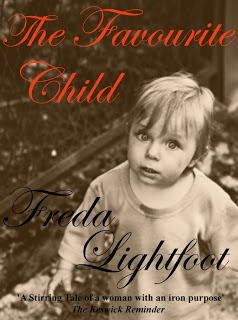 Do we class it as romantic fiction, a historical, or a genre in its own right? In the old Norse tradition it was a story of heroic achievement or marvellous adventure. In the modern version it's a nostalgic tale about ordinary people dealing with extraordinary events in their lives. The ingredients generally include a strong woman as the main character, striving against all odds to make her place in the world and ultimately find love. Also, people love to read about a place they know. It's not simply a question of painting pretty scenery. The setting must be an intrinsic part of the book, one that is familiar, which we can recognise and identify with.
Do we class it as romantic fiction, a historical, or a genre in its own right? In the old Norse tradition it was a story of heroic achievement or marvellous adventure. In the modern version it's a nostalgic tale about ordinary people dealing with extraordinary events in their lives. The ingredients generally include a strong woman as the main character, striving against all odds to make her place in the world and ultimately find love. Also, people love to read about a place they know. It's not simply a question of painting pretty scenery. The setting must be an intrinsic part of the book, one that is familiar, which we can recognise and identify with.
As well as this strong sense of place, the genre uses a multi-layered viewpoint and a page-turning plot. They deal with universal themes in a small domestic setting, social history at ground level, dealing with the position of women and the working classes, often forgotten in the larger dome of history. But then not all history was made on the battlefield. And it is important to set this domestic scene against a view of a wider world.
Catherine Cookson is considered to be the instigator of this genre, and made a point of dealing with difficult subjects, in particular women's issues: illegitimacy, abuse, class, divorce, rejection, adoption, betrayal, loss. There is no limit to the topics covered, and emotion can run high in these stories. In The Bobbin Girls the issue is how much damage can a lie do if it is big enough? In Kitty Little it is loyalty and betrayal. The Favourite Child concerns bringing contraception to the masses in the 1920s. Candy Kisses is about child abuse. And there are many more: 35 published titles so far, including my other historicals. In my latest sagas: The House of Angels and Angels at War, the story examines how the three sisters overcome the damage caused by an abusive father.
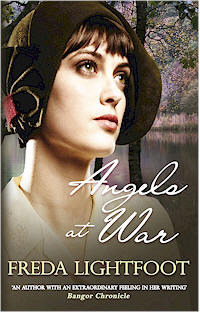
It is not always easy to write such difficult scenes yet from the emails I get, they often touch a chord. Anyone who has ever suffered abuse, whether as a child, or bullying in school, in a violent marriage, or even in the work place, will appreciate how the first thing you lose is self-esteem. You are demeaned, humiliated, debased and shamed so that you come to hate yourself, a deliberate ploy on the part of the abuser as it puts the power in his hand. The Angel sisters have to deal with all of that, find love and a happy ever after. Wherever human emotion is involved you can find a story, and a writer must be honest with her reader and write from the heart.
Here's the blurb for Angels at War, now out in paperback:
Two years have passed since Livia and her sisters suffered at the hands of their brutal father and Livia is set to marry the handsome and caring Jack Flint while her sisters are contentedly living at Todd Farm. Yet she dreams of bringing back to life the neglected drapery business which was left to her when her father died. But is she prepared to jeopardise the love she shares with Jack to achieve her wish?
Racked with guilt over the tragic death of her sister Maggie, she promises never to let anyone down again and to do something worthwhile with her life. But standing in her way is the wealthy and determined Matthew Grayson, who has been appointed to oversee the restoration of the business. His infuriating stubbornness clashes with Livia's tenacity and the pair get off to a bad start. But as her problems with Jack worsen, Livia finds it increasingly difficult to resist his charms. Despite all the emotional turmoil, she is also resolute in her support for the Suffragette Movement which puts further strain on her relationship with Jack. With the extra pressures of her sisters' problems, is it possible for Livia to regain control of her life?
I've now published 25 sagas and a couple of years ago began to feel the need for a change to freshen my creativity and add to my output, so struck out in a new direction.
I'll tell you more about that next week.

But what is a saga?
 Do we class it as romantic fiction, a historical, or a genre in its own right? In the old Norse tradition it was a story of heroic achievement or marvellous adventure. In the modern version it's a nostalgic tale about ordinary people dealing with extraordinary events in their lives. The ingredients generally include a strong woman as the main character, striving against all odds to make her place in the world and ultimately find love. Also, people love to read about a place they know. It's not simply a question of painting pretty scenery. The setting must be an intrinsic part of the book, one that is familiar, which we can recognise and identify with.
Do we class it as romantic fiction, a historical, or a genre in its own right? In the old Norse tradition it was a story of heroic achievement or marvellous adventure. In the modern version it's a nostalgic tale about ordinary people dealing with extraordinary events in their lives. The ingredients generally include a strong woman as the main character, striving against all odds to make her place in the world and ultimately find love. Also, people love to read about a place they know. It's not simply a question of painting pretty scenery. The setting must be an intrinsic part of the book, one that is familiar, which we can recognise and identify with. As well as this strong sense of place, the genre uses a multi-layered viewpoint and a page-turning plot. They deal with universal themes in a small domestic setting, social history at ground level, dealing with the position of women and the working classes, often forgotten in the larger dome of history. But then not all history was made on the battlefield. And it is important to set this domestic scene against a view of a wider world.
Catherine Cookson is considered to be the instigator of this genre, and made a point of dealing with difficult subjects, in particular women's issues: illegitimacy, abuse, class, divorce, rejection, adoption, betrayal, loss. There is no limit to the topics covered, and emotion can run high in these stories. In The Bobbin Girls the issue is how much damage can a lie do if it is big enough? In Kitty Little it is loyalty and betrayal. The Favourite Child concerns bringing contraception to the masses in the 1920s. Candy Kisses is about child abuse. And there are many more: 35 published titles so far, including my other historicals. In my latest sagas: The House of Angels and Angels at War, the story examines how the three sisters overcome the damage caused by an abusive father.

It is not always easy to write such difficult scenes yet from the emails I get, they often touch a chord. Anyone who has ever suffered abuse, whether as a child, or bullying in school, in a violent marriage, or even in the work place, will appreciate how the first thing you lose is self-esteem. You are demeaned, humiliated, debased and shamed so that you come to hate yourself, a deliberate ploy on the part of the abuser as it puts the power in his hand. The Angel sisters have to deal with all of that, find love and a happy ever after. Wherever human emotion is involved you can find a story, and a writer must be honest with her reader and write from the heart.
Here's the blurb for Angels at War, now out in paperback:
Two years have passed since Livia and her sisters suffered at the hands of their brutal father and Livia is set to marry the handsome and caring Jack Flint while her sisters are contentedly living at Todd Farm. Yet she dreams of bringing back to life the neglected drapery business which was left to her when her father died. But is she prepared to jeopardise the love she shares with Jack to achieve her wish?
Racked with guilt over the tragic death of her sister Maggie, she promises never to let anyone down again and to do something worthwhile with her life. But standing in her way is the wealthy and determined Matthew Grayson, who has been appointed to oversee the restoration of the business. His infuriating stubbornness clashes with Livia's tenacity and the pair get off to a bad start. But as her problems with Jack worsen, Livia finds it increasingly difficult to resist his charms. Despite all the emotional turmoil, she is also resolute in her support for the Suffragette Movement which puts further strain on her relationship with Jack. With the extra pressures of her sisters' problems, is it possible for Livia to regain control of her life?
I've now published 25 sagas and a couple of years ago began to feel the need for a change to freshen my creativity and add to my output, so struck out in a new direction.
I'll tell you more about that next week.

Published on July 06, 2011 23:00
June 30, 2011
Dark Days
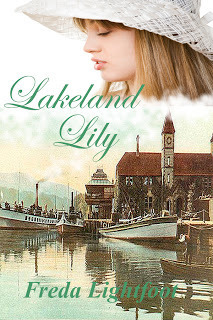 I was enjoying my new career. I finished that first series then went on to write Lakeland Lily which deals with snobbery, and the effects of World War I, followed by The Bobbin Girls, set against the wonderful back-drop of Grizedale Forest where two young people in love try to escape the disapproval of parents and make a new life for themselves. I signed a new contract for more books. Everything was going well. I'd achieved my dream. Life was good.
I was enjoying my new career. I finished that first series then went on to write Lakeland Lily which deals with snobbery, and the effects of World War I, followed by The Bobbin Girls, set against the wonderful back-drop of Grizedale Forest where two young people in love try to escape the disapproval of parents and make a new life for themselves. I signed a new contract for more books. Everything was going well. I'd achieved my dream. Life was good.And then one sunny day in August, 1998, I got the kind of call no parent ever wishes to receive. I learned that my daughter had been killed. She was 27. I'm not going to linger over this part of my story as it is too painful, even now. Bad things happen to good people all the time. You just don't expect it to happen to your own beautiful daughter.
The next few years were dark as we dealt with our grief. Writing, as you will appreciate, was the last thing on my mind. My publishers stood by me, put everything on hold and waited. My husband changed his job and we bought a small guest house. We still had to earn a living and being together every day helped enormously. My other daughter, and everyone else in the family was back at work. I had been a published writer for 10 years so felt I should do the same. The trouble was my brain was a lump of soggy pudding. Writing isn't something you can just turn on like a tap, and my muse had gone, my hunger to write had evaporated. What was the point of it all? I asked myself. Why should I even bother to try? They were just silly little paperbacks, with no value at all. Don't we all feel this way when real life suddenly becomes overpowering?
But my writer friends wouldn't allow me to be so defeatist. They convinced me that Anna would expect me to keep on writing, that she was as proud of my talents as I was of hers. They reminded me how the first thing someone does when dealing with sickness or loss, is to try to lose themselves in a story. People seek escape from their troubles, and often find it in the books they read, so writing novels isn't useless at all, they insisted. It's a service in it's own small way, a therapy as well as entertainment. Writing is a gift, one that in a strange way can transcend the horrors of life, the dark days of ill health and pain, and help you deal with them. It's a step into the sub-conscious, which operates on an entirely different level. Like in our teenage years when we wrote our troubled thoughts into a secret diary, as grown-ups we can still tap into that stream-of-consciousness writing. Which surely brings hope to us all?
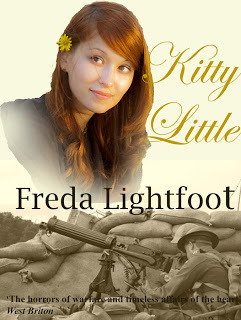
And so I booted up the computer but found I was unable to go back to the original novel, which held painful associations. It would be another two years before I felt able to go back to Kitty Little. Instead, I dug out an old rejected piece and started to rework it. My editor encouraged me, and in a bid to keep myself from falling into that dark bottomless pit, little by little I began to write again.
You can check out my ebooks here.
Buy from Amazon
Next week I'll be talking about Moving Forward, and what exactly is a saga.

Published on June 30, 2011 23:00
Freda Lightfoot's Blog
- Freda Lightfoot's profile
- 210 followers
Freda Lightfoot isn't a Goodreads Author
(yet),
but they
do have a blog,
so here are some recent posts imported from
their feed.



